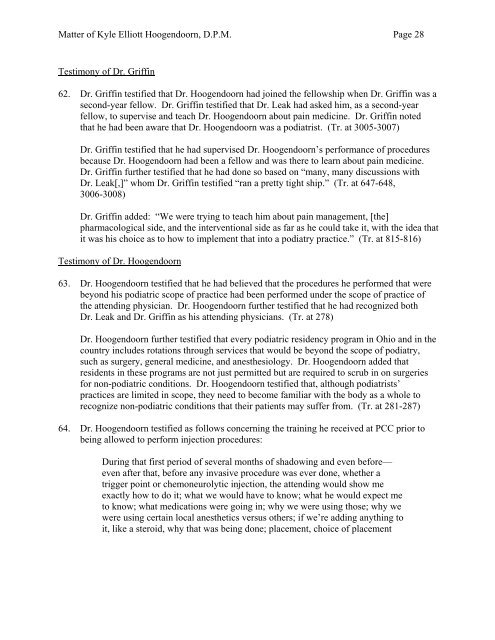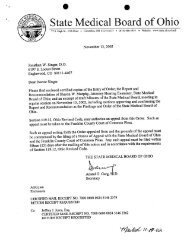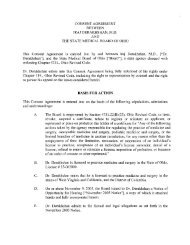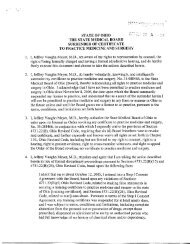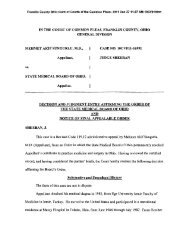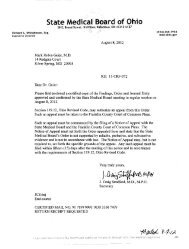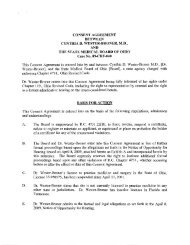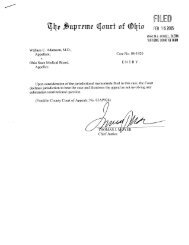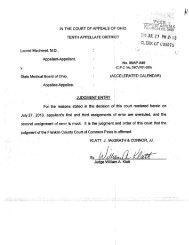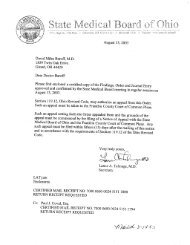CONSENT AGREEMENT BETWEEN - State Medical Board of Ohio ...
CONSENT AGREEMENT BETWEEN - State Medical Board of Ohio ...
CONSENT AGREEMENT BETWEEN - State Medical Board of Ohio ...
You also want an ePaper? Increase the reach of your titles
YUMPU automatically turns print PDFs into web optimized ePapers that Google loves.
Matter <strong>of</strong> Kyle Elliott Hoogendoorn, D.P.M. Page 28<br />
Testimony <strong>of</strong> Dr. Griffin<br />
62. Dr. Griffin testified that Dr. Hoogendoorn had joined the fellowship when Dr. Griffin was a<br />
second-year fellow. Dr. Griffin testified that Dr. Leak had asked him, as a second-year<br />
fellow, to supervise and teach Dr. Hoogendoorn about pain medicine. Dr. Griffin noted<br />
that he had been aware that Dr. Hoogendoorn was a podiatrist. (Tr. at 3005-3007)<br />
Dr. Griffin testified that he had supervised Dr. Hoogendoorn’s performance <strong>of</strong> procedures<br />
because Dr. Hoogendoorn had been a fellow and was there to learn about pain medicine.<br />
Dr. Griffin further testified that he had done so based on “many, many discussions with<br />
Dr. Leak[,]” whom Dr. Griffin testified “ran a pretty tight ship.” (Tr. at 647-648,<br />
3006-3008)<br />
Dr. Griffin added: “We were trying to teach him about pain management, [the]<br />
pharmacological side, and the interventional side as far as he could take it, with the idea that<br />
it was his choice as to how to implement that into a podiatry practice.” (Tr. at 815-816)<br />
Testimony <strong>of</strong> Dr. Hoogendoorn<br />
63. Dr. Hoogendoorn testified that he had believed that the procedures he performed that were<br />
beyond his podiatric scope <strong>of</strong> practice had been performed under the scope <strong>of</strong> practice <strong>of</strong><br />
the attending physician. Dr. Hoogendoorn further testified that he had recognized both<br />
Dr. Leak and Dr. Griffin as his attending physicians. (Tr. at 278)<br />
Dr. Hoogendoorn further testified that every podiatric residency program in <strong>Ohio</strong> and in the<br />
country includes rotations through services that would be beyond the scope <strong>of</strong> podiatry,<br />
such as surgery, general medicine, and anesthesiology. Dr. Hoogendoorn added that<br />
residents in these programs are not just permitted but are required to scrub in on surgeries<br />
for non-podiatric conditions. Dr. Hoogendoorn testified that, although podiatrists’<br />
practices are limited in scope, they need to become familiar with the body as a whole to<br />
recognize non-podiatric conditions that their patients may suffer from. (Tr. at 281-287)<br />
64. Dr. Hoogendoorn testified as follows concerning the training he received at PCC prior to<br />
being allowed to perform injection procedures:<br />
During that first period <strong>of</strong> several months <strong>of</strong> shadowing and even before—<br />
even after that, before any invasive procedure was ever done, whether a<br />
trigger point or chemoneurolytic injection, the attending would show me<br />
exactly how to do it; what we would have to know; what he would expect me<br />
to know; what medications were going in; why we were using those; why we<br />
were using certain local anesthetics versus others; if we’re adding anything to<br />
it, like a steroid, why that was being done; placement, choice <strong>of</strong> placement


